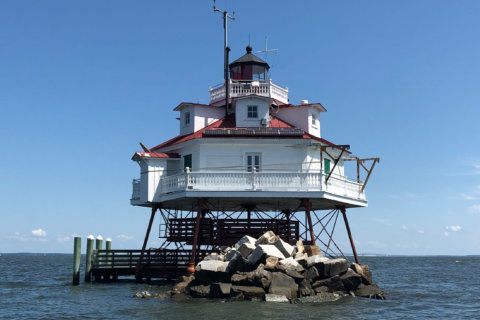This article was republished with permission from WTOP’s news partners at Maryland Matters. Sign up for Maryland Matters’ free email subscription today.
This content was republished with permission from WTOP’s news partners at Maryland Matters. Sign up for Maryland Matters’ free email subscription today.
The Board of Public Works will put off a discussion and vote on Gov. Larry Hogan’s highway widening proposal, which had been scheduled for May 8, an administration official told Maryland Matters Friday morning.
“We plan to postpone consideration of this item,” Hogan’s communications director, Michael Ricci, said in an email. “This will give the treasurer a chance to weigh in as we work to address one of the worst traffic problems in the country.”
It was not immediately clear Friday morning when the item would return to the BPW agenda.
Hogan had been under pressure to delay the vote because State Treasurer Nancy K. Kopp, one of three members of the Board of Public Works and an avowed skeptic of Hogan’s plan to widen the Capital Beltway and Interstate 270, was going to miss the meeting due to a long-scheduled vacation. Kopp, who serves on the board with Hogan and Comptroller Peter Franchot (D), will be in Japan with her husband next week, celebrating their 50th wedding anniversary.
She said she informed her colleagues of her travel schedule months ago, and she has formally requested that action on the governor’s plan to increase capacity on the Capital Beltway and Interstate 270 be delayed until the panel’s May 22 meeting.
The item, one of dozens of decisions on the board’s long agenda, would officially designate Hogan’s road-widening plan as a public-private partnership and it would approve a proposed competitive bid process for selecting private-sector firms to handle financing and construction.
On Thursday, 36 state lawmakers from Montgomery and Prince George’s counties wrote to Hogan, urging him to delay the vote until Kopp could be present.
“They need to [postpone] this,” Del. Kumar P. Barve, D-Montgomery County, the chair of the House Transportation and Environment Committee and one of the signatories to the letter, said in an interview. “This is bull—-. This kind of behavior is why people hate American government.”
In an interview, Kopp said she has many questions and concerns about Hogan’s plan to widen the Beltway and I-270 two lanes in each direction. Even if she was going to be in attendance next week, Kopp asserted that she doesn’t think the issue is “ripe” for action.
“This issue is of such great importance — both because of the cost and the fact that we’re building an infrastructure that’s lasting for more than half a century — that it deserves more consideration,” she said. “It is appropriate for the state treasurer to be part of that discussion.”
Ricci said the governor is scheduled to be out of town when the panel convenes on May 22.
In addition to their request that the Board of Public Works wait until Kopp returns from overseas, Montgomery and Prince George’s lawmakers said they want each phase of the project broken into its own separate public-private partnership, or P3.
“Each segment of I-495 and I-270 faces unique conditions and challenges and should be considered on its own merits,” they write.
State leaders maintain that Maryland lacks the borrowing capability to fund road expansion and have decided to use a P3 approach instead. This will allow for private sector firms with deep pockets and global experience to fund, construct and maintain the new lanes in exchange for the right to charge tolls on the new express lanes.
But the financing scheme the state envisions is complicated. A key document, a supplement to the Pre-Solicitation Report, was just made public and delivered to the treasurer’s office this week — even though it is dated April 12.
Critics of the governor’s plan say there was insufficient time to digest the new information by May 8.
“This is a really complicated legal document,” said Ben Ross of the Maryland Transit Opportunities Coalition. “There is no way on earth that the public and even the state treasurer’s office can get to the bottom of all the implications of this before Wednesday morning.”
Kopp said her staff is reviewing the document, which it received on Tuesday.
The legislators’ letter makes their concerns plain.
The Maryland Department of Transportation “has itself represented at public meetings that it is not ready to share the support for its traffic model, and no detailed analyses of the costs and financial risks of the Program have been provided,” the lawmakers wrote.
“There is great uncertainty involved for the state, taxpayers, and individual motorists in acting without full information on the choices for traffic relief in Maryland.”
As elected officials in the two most affected counties stewed over what they claim is the state’s rush job — and its unwillingness to seriously consider alternatives — the top planner with the Montgomery County Planning Department, and the agency’s top lawyer, aired a series of concerns about the project in a memo to the Maryland National Capital Park and Planning Commission on Monday.
In the memo, Carol S. Rubin, special project manager for the I-495 & I-270 Managed Lanes Study, and Principal Counsel Debra Borden fault M-DOT and the State Highway Administration for not incorporating comments from local planners into a key state document.
“In fact,” they write, “M-DOT SHA made almost no change from the Screened Alternatives to the [Alternatives Retained for Detailed Study].”
The “lack of any significant transit elements in the selected screened alternatives is unacceptable,” they write in the first of 18 bullet points. In addition, they claim the state’s environmental screening criteria was “insufficient” and that “more detail is needed on the noise impact evaluation process.”
As for how the governor’s plan would affect the Beltway in the Temple Hills/Oxon Hill portion of Prince George’s, the planners tartly conclude that “the state apparently intends to rely upon Virginia to design and implement a segment of I-495 that provides access to the most significant economic assets in Prince George’s County.”
“It’s a shocking letter, honestly,” said Democrat Tom Hucker, chair of the Montgomery County Council’s transportation committee and a former state legislator.
“Highly unusual. I’ve never seen one like it with such a damning criticism of a compromised state agency by a highly-respected, non-partisan expert government entity.”
The State Highway Administration did not immediately respond to a request for comment on Thursday evening.
SHA is conducting a series of “public workshops” at which state planners brief the public about the plans to widen the two roads, but many officials and residents have been frustrated by the lack of opportunity to make formal comments at these gatherings. (Comments can be submitted online on a dedicated web page the state has created.)
Hucker has organized an I-495/I-270 Town Hall for Sunday from 11 a.m. to 1 p.m. at the Silver Spring Civic Building to give residents the chance to speak. Montgomery County Executive Marc B. Elrich and U.S. Rep. Anthony G. Brown, both Democrats, will be among the speakers, Hucker said.
Franchot has been invited, but his participation has not been confirmed.
In the meantime, opponents of the governor’s plan continue to pressure Kopp and Franchot to use their power on the BPW.
“They’re the only people who have a say in the process,” Barve said. “Everything else is secondary at this point.”
“Comptroller Franchot has spent a lot of time talking about how he’s the watchdog for the taxpayers. Now’s his opportunity to be a watchdog over what is reportedly the largest P3 in American history.”







